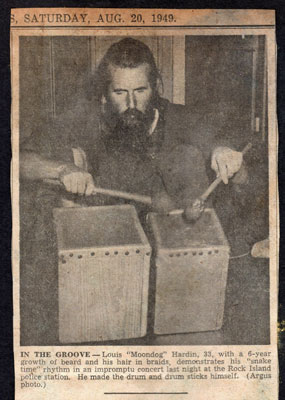
(in: There's a Stranger in Town by James H. Payne,
20. August, 1949, Argus photo)
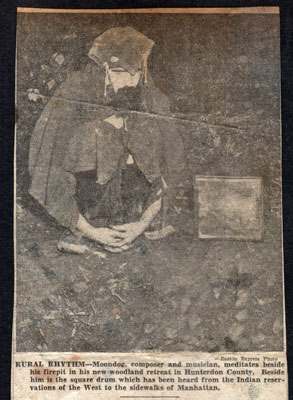
Sometimes he steps over to speak an encouraging word to a Cornish game hen, setting in a basket built of twigs, log-cabin style. Sometimes he squats with his square drum and lets its single head speak for the startled study of redbirds.
(in: Community Crossroads by Ben Kizer, ca. 1950, Easton Express Photo)
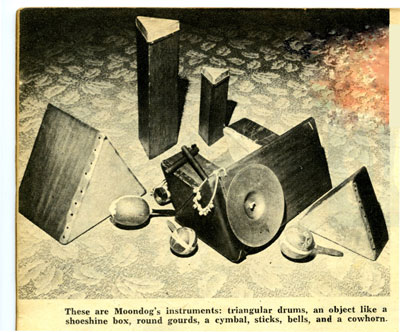
These are Moondog's instruments: Triangular drums, an object like a shoeshine box, round gourds, a cymbal, sticks, bells, and a cowhorn. One original creation is the trimba, a series of ten drums, triangular in shape, used in graduated sizes. Moondog has used the trimba in recordings to introduce rhythms of snaketime. (in: Moondog, People Magazine, March 7, 1956) |
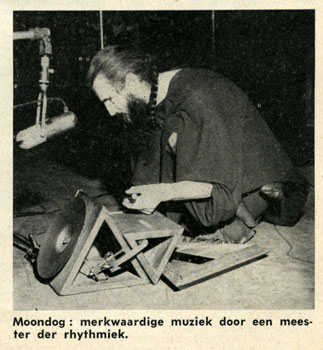 Moondog with Trimba (and Oo) (in: Rhythme, 1954, 15 Oct., Jazztime U.S.A) |
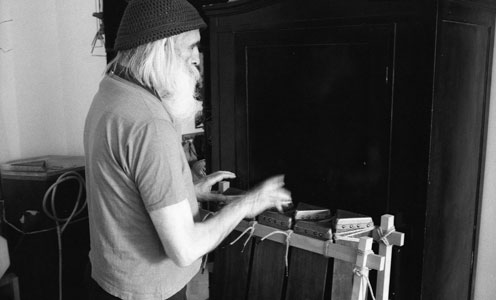
Moondog in Schweden, 1986, Photo: Stefan Lakatos |
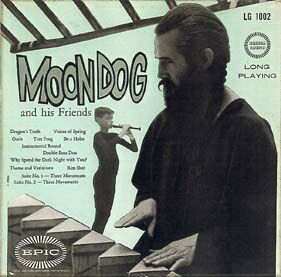
Dragon's Teeth: This number serves to introduce the trimba, a series of ten drums, triangular in shape, used in graduated sizes. (LP Moondog and his Friends, 10" Epic LG 1002, 1954) |
The Oo
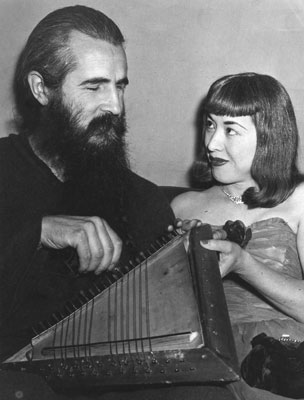
Photo: Moondog and his wife Suzuko, Philly,1955 … the "oo," a triangular 25-stringed harp, … (in: Records: Moondog, by John Briggs, NY Times, 1953) What's an oo? "A harp-like affair with a triangular frame and sounding board; it can be tuned anyway I like - happen to be pentatonic at the moment, but I change it often. It's played with claves, using a teeter-totter technique that gives bounce; mostly offbeat playing against drums' onbeat playing." (in: Oo, That Frantic Snaketime, by Leonard Feather, Downbeat, July 1,1953) His wife ran a thumbnail across a homemade harp of wooden quarter-inch dowels instead of strings and produced an uncanny but musical sighing sound. (in: 'Moondog' in Debut, by Paul V. Beckley, NY Herald Tribune, 1953) Moondog was playing, with his right hand, a percussion instrument of his own devising, and with the other, an equally unusual stringed instrument, which he calls an "Oo." The stringed instrument is an equilateral triangle with piano strings uned to a seven-note scale with two augmented seconds. Moondog played it with a clavis, a wooden affair not unlike a pharmacist's pestle. (in: Moondog's Euphonies, by Jack O'Brian) |
The Tuji - The Utsu - The Uni
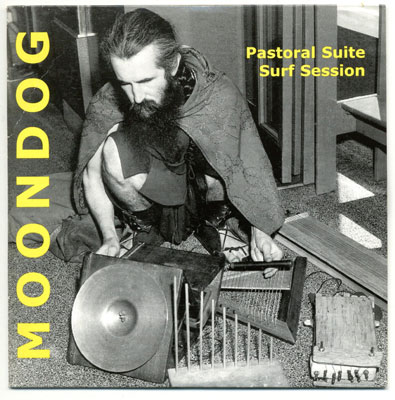
EP Cover (ori: Dan Grossi,1953), In the front from left: Trimba, Tuji, Utsu In Moondogs left hand: A clave, playing the Oo Behind right: Uni The Tuji An instrument with nine tuned wooden pegs (in: Records: Moondog, by John Briggs, NY Times 1953) Sometimes, with a thing he (Moondog) calls a tuji, he creates a darting rattle like that of an angry Western diamond back. (in: 'Moondog' in Debut, by Paul V. Beckley, NY Herald Tribune, 1953) The Utsu A rudimentary keyboard instrument tuned to the pentatonic scale G-A-B-D-E (the same intervals as the black keys on the piano). (in: Records: Moondog, by John Briggs, NY Times, 1953) The Utzu is a small keyboard device tuned to the five note Chinese scale. (in: Moondog; Study In Snaketime …, ca. 1953) Utsu, Suzuko plays the Utsu in 5-4 time. Introducing the Utsu, a small, keyboard instrument in the 5-tone scale. (EP On the Streets of New York, Mars, 1953) The Uni The Uni (short for unsison) has guitar like strings all tuned to the same pitch. (in: Moondog; Study In Snaketime by Donald Dunkerly, ca. 1953) Chant, introducing the Uni (7 strings in unison). A pedal point to a two part round for voice and Utsu in 1-2 time. (EP On the Streets of New York, Mars, 1953) The uni is a seven-stringed instrument that can be plucked like a harp, struck with a mallet, like a piano, or played with a bow. (10" LP Moondog and Friends, 1954) A seven-stringed zither (in: Records: Moondog by John Briggs, NY Times, 1953) "The uni is based on the word unsison. I use it as a pedal point or drone bass to music written in a 5-, 6- or 7-tone scale. You can strum the seven strings like a harp, hit them with a mallet, or you can get a weird sound and many harmonics by playing them with a double bass bow. The strings are made of piano wire." (in: Oo, That Frantic Snaketime by Leonard Feather, Downbeat, July 1,1953) |
The Samisen
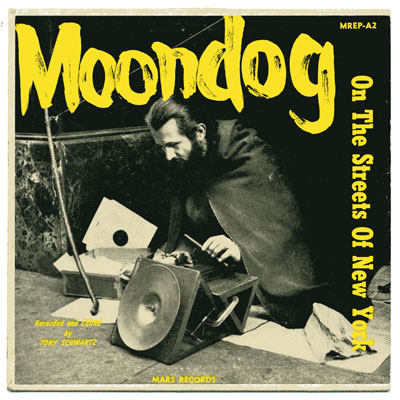
EP Moondog On The Streets Of New York Cover Photo by Benn Michell In front: Trimba Left: Stick with one string (Samisen?) A single-stringed, bowed instrument of Japan (in: Records: Moondog, by John Briggs, NY Times, May 31st, 1953) "The samisen, as far as I could gather, is a kind of portis on the franistan, which can be glaviolated with artificial snerbs." (in: Oo, That Frantic Snaketime, by Leonard Feather, Downbeat, July 1,1953) Lullaby (2 West 46th Street), Suzuko sings in three octaves against Samisen, etc. (EP On the Streets of New York, Mars, 1953) |
Hexagonal Drums
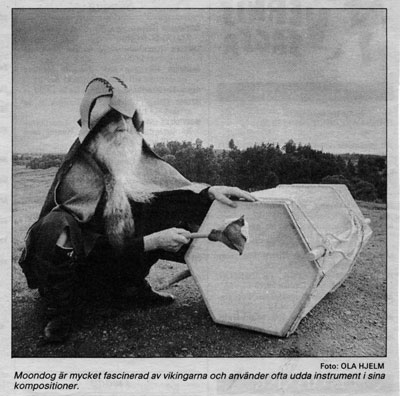
(in: Moondog - rosad särling, by Måns Wallgren, , 21. - 28. Maj, 1988, Dagens Nyheter, Sweden) |
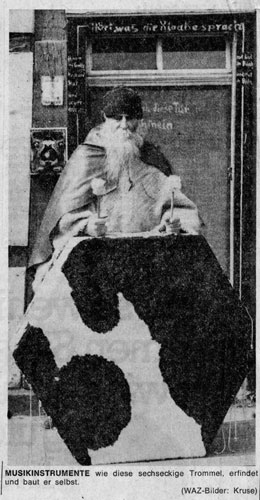
(in: Die Straße gibt ihm die nötige Stimulanz, hol., 6.6.1975 WAZ, Germany) From the Guestbook Archive: willem wittstamm, 13.08.2008 I was happy enough to live with moondog for a while in our Hexenhäuschen in Recklinghausen, leading him to the streets corner where he spent his day reciting and drumming. Quotation: "came to germany to bring you back the drumming". Never forget the big "Hagall-drum" we played on winter solstice. Really blew me away! The skin was from the Recklinghausen slaughterhouse, he had spend days and nights in our bathroom cleaning the bloody skin with knife and salt, what a mess, what a smell, what a character. We always invited him to our hippie feasts, he played the drum like hell, then suddenly layed down, slept deep in the middle of the orgie, woke up, played on. More info on demand, greetings willem |
Troubadour Harp
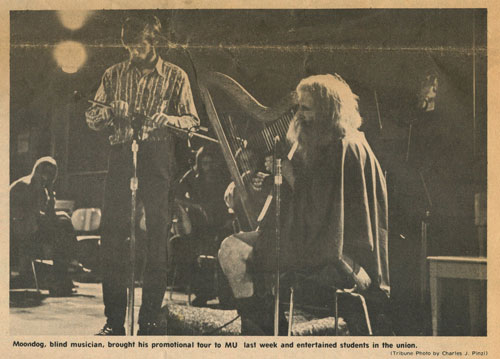
"He stopped at Madison where he had a troubadour harp made for him by a couple of musical instrument makers there." (in: Moondog brings his poetry to campus, by E.J. Birdie, The Marquette Tribune, Milwaukee, Wis., September 20, 1972) |
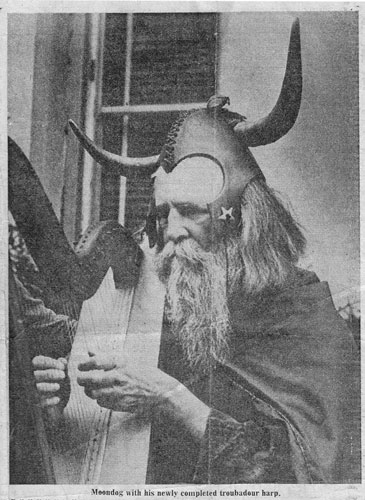
(in: Moondog Gets a Harp and A Very Warm Feeling, by Emily C. Bucher, Capital Times, September 20, 1972) |